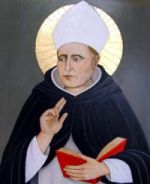Catholic Recipe: Holy Thursday Meal Menu
INGREDIENTS
- The bone from the roasted leg of lamb
- Matzos, unleavened bread or crackers
- Bitter herbs, Horseradish or spring radishes, celery
- Haroses, made of apples, nuts, cinnamon and wine
- Greens, parsley or watercress
- Water with salt
Details
Prep Time: 1 day
Difficulty: ★★☆☆
Cost: ★★☆☆
For Ages: 11+
Origin: Israel
showFood Categories (1)
showSimilar Recipes (10)
- Agnello al Forno (Roast Suckling Lamb)
- Charoses
- Haroset
- Horoseth
- Leg of Lamb
- Matzah
- Matzo Bread
- Roast Leg of Spring Lamb
- Unleavened Bread
- Whole Baby Lamb
showLinked Activities (11)
- Holy Saturday and Easter in the Home
- Holy Thursday Meal in the Home -- Remembering the Last Supper
- Maundy Thursday and the Passover Meal
- The Passover Meal: 1. Introduction
- The Passover Meal: 2. Preparing for the Celebration
- The Passover Meal: 3. Meal Preparation
- The Passover Meal: 4. Introductory Blessings
- The Passover Meal: 5. Traditional Passover Prayers
- The Passover Meal: 6. The Questions
- The Passover Meal: 7. Hallel: Psalms of Praise
- The Passover Meal: 8. The Concluding Hallel
showFeasts (1)
showSeasons (1)
For Christian families remembering Christ's heritage, celebrating a meal on Holy Thursday in memory of the Last Supper is a great tradition.
DIRECTIONS
Seder Meal Preparation
The room is prepared for a truly festive occasion. The table or tables are set with the best silver, dishes, linen and flowers. The children may make large banners on shelf paper of the Paschal lamb, breads on a platter, the Last Supper, phrases from the scriptures, chalices, loaves and fishes, brick walls to symbolize the slavery of the Jews, and marked doorposts or any other gaily colored symbolic pictures of their own making. In this way the children can enjoy a creative experience, decorate the home or hall and learn through symbolism. A wine glass (or grape juice for the young children) is set before each place. The centerpiece is a white frosted cake, molded in the shape of a lamb, or an angel food cake whose circular shape symbolizes eternal life. A candle is placed at the head of the table.
The food for the meal is carefully prepared and served, announcing to all present that this is indeed a special feast. If possible, the menu contains the symbolic foods which are required for the feast of the Passover.
The Seder Plate
Jewish custom arranges on one plate the symbolic food used during the service. If the ecumenical gathering of family and friends is large, small bowls of these foods will also be placed at intervals in easy reach of all. On the Seder plate or tray are arranged several items.
The bone from the roasted leg of lamb is always at the Jewish table and may be on ours. It symbolizes the sacrificial lamb offered by the Israelites and was eaten on the eve of their departure from Egypt. Whether we actually eat lamb at this meal or not, Christians have retained the symbolism of the Lamb of God.
Matzos, in memory of the unleavened bread which the Jews ate when they were freed from Egypt. (If you cannot obtain Matzos use white crackers, placing the whole sheet on the table so that portions may be broken off.)
Bitter herbs, for the bitterness of slavery. Horseradish or spring radishes may be used.
Haroses, a food made of apples, nuts, cinnamon and wine, chopped and mixed together to look like the mortar which the Hebrew slaves used in their servitude.
Greens, parsley or watercress, used as a token of gratitude to God for the products of the earth.
Water with salt added in another small dish is needed into which to dip the greens and bitter herbs.
Recipe Source: Passover Meal, The by Arleen Hynes, Paulist Press, 1972Sat15 NovemberOrdinary TimeSaturday of the Thirty-Second Week in Ordinary Time; Opt Mem of St. Albert the Great, Bishop & Doctor of the Church

Today the Church celebrates the Optional Memorial of St. Albert the Great (c. 1200-1280), son of a German nobleman. While studying at Padua when the Master General of the Dominicans, Jordan of Saxony, succeeded in attracting him to that Order. He was to become one of its greatest glories. After taking his…
Subscribe to Insights...free!News, analysis & spirituality by email twice-weekly from CatholicCulture.org.Copyright © 2025 Trinity Communications. All rights reserved.





